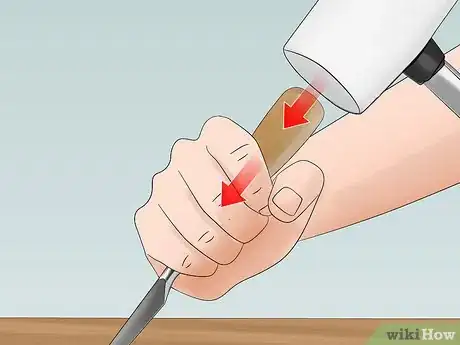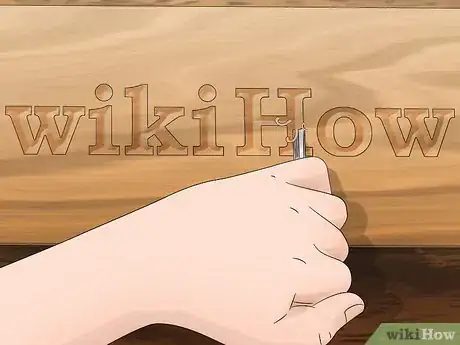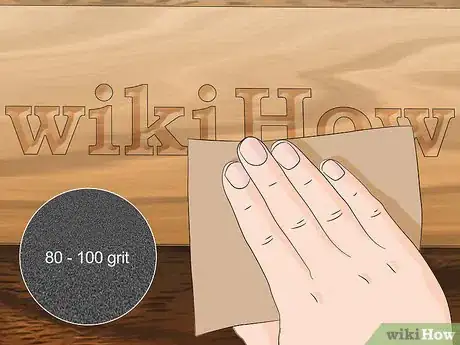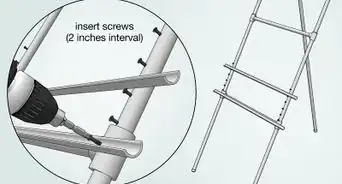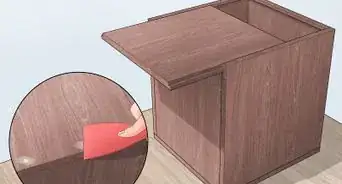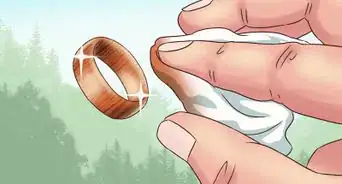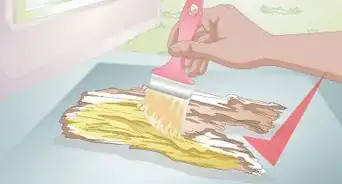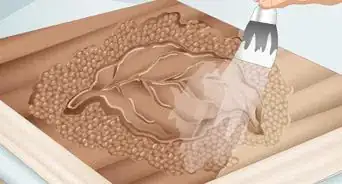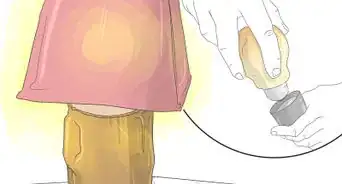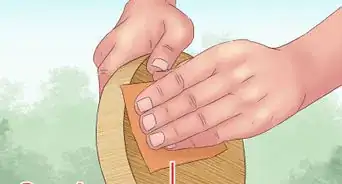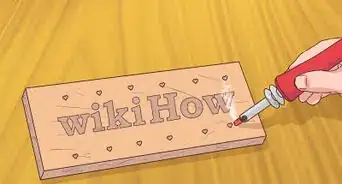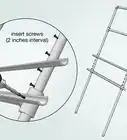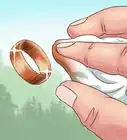This article was co-authored by wikiHow staff writer, Hunter Rising. Hunter Rising is a wikiHow Staff Writer based in Los Angeles. He has more than three years of experience writing for and working with wikiHow. Hunter holds a BFA in Entertainment Design from the University of Wisconsin - Stout and a Minor in English Writing.
There are 15 references cited in this article, which can be found at the bottom of the page.
This article has been viewed 56,394 times.
Learn more...
Carving letters into wood is a great craft project you can use to make personalized signs or decorations. If you want to start wood carving, all you need are a few tools, some wood, and a space to work in. We'll show you how to plan and place the letters, then carve them either by hand or with a rotary tool.
Things You Should Know
- Use a softwood like basswood, butternut, or walnut for easy and reliable carving.
- Sketch your letters onto the wood freehand, or use carbon paper to trace printed letters onto the surface.
- Chisel inside the outlines of the letters with a right-angle chisel, tapping its handle firmly with a rubber mallet.
- Alternatively, use a rounded cutting bit on a rotary tool, and apply gentle pressure to the wood to grind out the letters.
Steps
Transferring Letters to the Wood
-
1Pick softwoods for the easiest carving experience. Softwoods keep your tools sharp and are easier to work on without breaking. Pick woods such as basswood, butternut, or pine to get started. Make sure there are no warps or defects in the wood you select or else you may have more difficulty carving it.[1]
- If you’ve carved wood before, you can try using hardwoods, like maple, cherry, or red oak. When you use hardwoods, you will need to carve slower and use more force to chip pieces off.
-
2Draw the letters on the wood with a pencil if you want them freehand. If you want to carve unique letters or something that looks handwritten, use a pencil to draw your design. Work directly on the wood while you write the letters. Block letters work best for carving out, but you can also use thin lettering if you want.[2]
- Don’t press too hard with your pencil since it could dent the wood or be hard to erase later on.
Tip: Try using a white pencil on darker woods so you can see your lines easier.
Advertisement -
3Trace letters on top of carbon paper if you want to use a printed font. Type the letters you want to carve in a text document on your computer. Make the font size large enough to fit your piece of wood and print it on a sheet of paper. Use clear tape to secure the printed letters to the light side of a piece of carbon paper. Set the paper on top of your wood so the dark side of the carbon paper faces down. Trace the outlines of your letters slowly with a pencil to transfer them onto your wood.[3]
- You can buy carbon paper at an office supply store or online.
- Avoid rubbing the paper with your hand since you could leave smudges on your wood.
- You can also trace pre-made stencils if you want.
-
4Clamp the piece of wood to your work surface. Secure your wood to your work surface by tightening it in a hand clamp. Make sure the clamp isn’t in the way of where you want to carve your letters. Try pushing the wood to see if it moves, and if it does, put another clamp on the opposite side as the first one.[4]
Using Hand Tools
-
1Hold a right-angle chisel against your wood. A right-angle chisel has a V-shaped end that’s able to cut larger chunks from your wood. Put your thumb on the ferrule, or the base of the chisel blade so the V-shape is face-up. Keep the point at the bottom of the V along your letter’s outline.
- Right-angle chisels can be purchased from your local hardware store.
- Chisels come in many widths so be sure to use one that’s similar in width to your outlines.
- If you’re carving out a block letter, place the point of your chisel just inside the outline. If you want a beveled edge, put the chisel directly on your outline.
-
2Push and tilt the chisel forward to carve into the wood. Lightly push the chisel forward along your outline and tilt the handle up slightly. The blade will start going into the wood and carve along the line. Start with a shallow cut first, carefully following your outline to remove the wood. When you hit the edge of your outline, tilt the blade handle down to break the piece off.[5]
- Never put your other hand in front of the chisel blade since you could get hurt if the chisel slips.
Tip: Practice using your chisel on a scrap piece of the same material to get an idea of how it feels to carve it.
-
3Use the edge of a flat chisel to break off smaller pieces of wood. A flat chisel has a straight, sharp edge for making precise cuts. Hold your chisel so the beveled edge faces up and tilt it at the angle you want to make your cut. Press the edge into the wood until you reach the depth that you want to cut out. Work the chisel blade toward the areas you already cut with your right-angle chisel so the wood breaks off easily. Wipe away any wood shavings that are in the way between each cut.[6]
- Flat chisels work great for making straight edges and vertical cuts.
-
4Hit the end of the chisel with a mallet if the wood is too hard to chisel by hand. If you have difficulty getting your chisel through the wood, use your other hand to lightly tap the chisel’s handle with a mallet. Don’t hit the mallet too hard or else you could gouge the wood you’re using. Keep hitting the chisel until you can carve through the wood easily again.[7]
- If you’re too nervous to use a mallet, try hitting the handle with the palm of your hand first.
- Some hardwoods, such as white oak, can’t be carved unless you use a mallet.
-
5Keep carving out your letter until it’s finished. Continue chiseling your letters with your right-angle or flat chisel. Make sure to stay within your outlines so you have a clean finish on your wood. You can carve the wood as deep as you want, but cutting into more than ¾ of its thickness may weaken it.[8]
- Go slowly around curves so you have the most control.
- Use your right-angle chisel for more precise cuts and shaping your wood, and use your flat chisel to remove larger chunks of wood.
-
6Sand the edges to remove any leftover wood. When you finish carving your wood, use 80- or 100-grit sandpaper to smooth your chisel cuts. Wipe the sawdust off of the wood as you sand so you can see what areas you still need to work on. Keep working around all of the edges until they’re smooth to the touch.[9]
- If your letters aren’t deep in the wood, sanding them too much could make them lose detail.
- Make sure to remove any pencil or carbon marks when you’re sanding.
Using a Rotary Tool
-
1Use rounded cutting bits for the best line control. Cutting bits for your rotary tool look like small flames with various cutting edges on them.[10] Press the lock button near the end of the rotary tool and feed your cutting bit into your tool. While you’re still holding down the lock button, spin the cutting bit clockwise to tighten it in place.[11]
- You can purchase a rotary tool from your local hardware store.
- A standard rotary tool set has 3-4 rounded cutting bits in different sizes. Otherwise, you can buy new sets or bits from your local hardware store.
- Make sure your rotary tool is unplugged before changing the bits.
- Pick larger bits to make wider cuts and smaller bits for precise, narrow cuts.
-
2Plug your rotary tool in and turn it on. Make sure the cord is out of the way so it’s not near the end of your rotary tool. Hold the tool with your dominant hand and use your thumb to turn it on to a moderate speed. When you want to turn it off again, slide the switch into the OFF position.[12]
- Wear safety glasses while working with your rotary tool to protect your eyes.
- Keep your fingers away from the end of your rotary tool while it’s spinning.
-
3Press the bit into the wood and follow along the outline to carve it out. Hold your piece of wood steady with your non-dominant hand. Push the tip of your rotary tool into the wood to start carving it. Start by making shallow carves along your letter outlines. Cut around the outside of your lines to make the letters 3D, or carve the inside of your letters to make them inset. Keep working around your outlines until you’ve completed your carve.[13]
- Work in one direction while you carve your wood or else it might look inconsistent.
- Change the bit you’re using to change the size of your carve. Use smaller bits for finer lines and larger ones to carve more wood from the area.
Tip: Try holding the rotary tool at an angle or sideways to carve out a larger line in your wood.
-
4Wipe sawdust away frequently. As you use your rotary tool, sawdust will start building up in your cuts and on your work surface. Once every 4-5 carves you make, wipe the wood clean with your hands or shake it out so you can see where you’re working. Cleaning helps you make sure your lines are straight and level with one another.[14]
-
5Sand any edges if you want them smoothed out. Sandpaper helps you reach small areas and makes your letters have a smooth finish. Use 80- or 100-grit sandpaper where you cut your piece with your rotary tool until the surface looks level. Then, rub the edges of your letters if you want them rounded.[15]
- Some rotary tools also have a sanding bit that you can use.
Warnings
- Wear safety glasses whenever you work with power tools.⧼thumbs_response⧽
- Always keep your hand behind the chisel’s blade so you don’t get hurt in case the chisel slips.⧼thumbs_response⧽
Things You’ll Need
Transferring Letters to the Wood
- Softwood
- Pencil
- Carbon paper
- Tape
Carving Letters into Wood by Hand
- Clamp
- Right-angle chisel
- Mallet
- Flat chisel
- Sandpaper
- Vacuum
Using a Rotary Tool
- Rotary tool
- Rounded cutting bits
- Safety glasses
- Sandpaper
References
- ↑ https://www.workshopshed.com/2018/04/best-wood-types-for-woodcarving/
- ↑ https://youtu.be/SrWIUwAxIW8?t=185
- ↑ https://youtu.be/qRDKHrnT04I?t=147
- ↑ https://youtu.be/SrWIUwAxIW8?t=133
- ↑ https://youtu.be/SrWIUwAxIW8?t=256
- ↑ https://youtu.be/SrWIUwAxIW8?t=387
- ↑ https://youtu.be/SrWIUwAxIW8?t=325
- ↑ https://youtu.be/SrWIUwAxIW8?t=734
- ↑ http://www.carvingmagazine.com/wood-carving/projects/26-carving-an-outdoor-sign







